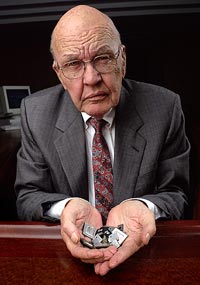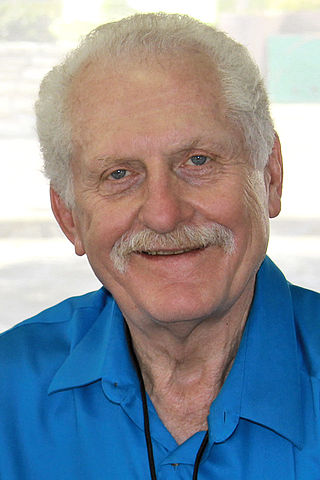Related Research Articles

Digital cinema refers to the adoption of digital technology within the film industry to distribute or project motion pictures as opposed to the historical use of reels of motion picture film, such as 35 mm film. Whereas film reels have to be shipped to movie theaters, a digital movie can be distributed to cinemas in a number of ways: over the Internet or dedicated satellite links, or by sending hard drives or optical discs such as Blu-ray discs.

Texas Instruments Incorporated (TI) is an American multinational semiconductor company headquartered in Dallas, Texas. It is one of the top 10 semiconductor companies worldwide based on sales volume. The company's focus is on developing analog chips and embedded processors, which account for more than 80% of its revenue. TI also produces digital light processing (DLP) technology and education technology products including calculators, microcontrollers, and multi-core processors.

Jack St. Clair Kilby was an American electrical engineer who took part, along with Robert Noyce of Fairchild Semiconductor, in the realization of the first integrated circuit while working at Texas Instruments (TI) in 1958. He was awarded the Nobel Prize in Physics on 10 December 2000.

An LCD projector is a type of video projector for displaying video, images or computer data on a screen or other flat surface. It is a modern equivalent of the slide projector or overhead projector. To display images, LCD projectors typically send light from a metal-halide lamp through a prism or series of dichroic filters that separates light to three polysilicon panels – one each for the red, green and blue components of the video signal. As polarized light passes through the panels, individual pixels can be opened to allow light to pass or closed to block the light. The combination of open and closed pixels can produce a wide range of colors and shades in the projected image.

A video projector is an image projector that receives a video signal and projects the corresponding image onto a projection screen using a lens system. Video projectors use a very bright ultra-high-performance lamp, Xenon arc lamp, metal halide lamp, LED or solid state blue, RB, RGB or fiber-optic lasers to provide the illumination required to project the image. Most modern projectors can correct any curves, blurriness and other inconsistencies through manual settings.

Digital light processing (DLP) is a set of chipsets based on optical micro-electro-mechanical technology that uses a digital micromirror device. It was originally developed in 1987 by Larry Hornbeck of Texas Instruments. While the DLP imaging device was invented by Texas Instruments, the first DLP-based projector was introduced by Digital Projection Ltd in 1997. Digital Projection and Texas Instruments were both awarded Emmy Awards in 1998 for the DLP projector technology. DLP is used in a variety of display applications from traditional static displays to interactive displays and also non-traditional embedded applications including medical, security, and industrial uses.

A spatial light modulator (SLM) is a device that can control the intensity, phase, or polarization of light in a spatially varying manner. A simple example is an overhead projector transparency. Usually when the term SLM is used, it means that the transparency can be controlled by a computer.

Cecil Howard Green was a British-born American geophysicist, electrical engineer, and electronics manufacturing executive, who trained at the University of British Columbia and the Massachusetts Institute of Technology.

A handheld projector is an image projector in a handheld device. It was developed as a computer display device for compact portable devices such as mobile phones, personal digital assistants, and digital cameras, which have sufficient storage capacity to handle presentation materials but are too small to accommodate a display screen that an audience can see easily. Handheld projectors involve miniaturized hardware, and software that can project digital images onto a nearby viewing surface.
Wobulation is the known variation ("wobble") in a characteristic. For example, wobulation of advanced radar waveform modulations – where the repetition rate or center frequency of a signal is changed in a repetitive fashion to reduce the probability of interception.

Stuart Stephen Papworth Parkin is an experimental physicist, Managing Director at the Max Planck Institute of Microstructure Physics in Halle and an Alexander von Humboldt Professor at the Institute of Physics of the Martin-Luther-University Halle-Wittenberg.

Christie is an audiovisual company that specializes in digital projection and projection tools for cinema and enterprise markets, video walls, content management, image processing, video wall processors, and SDVoE technology. The company has been granted over 100 patents.

Gordon Kidd Teal was an American engineer. He invented a method of applying the Czochralski method to produce extremely pure germanium single crystals used in making greatly improved transistors. He, together with Morgan Sparks, invented a modification of the process that produced the configuration necessary for the fabrication of bipolar junction transistors. He is most remembered for developing the first silicon transistor while at Texas Instruments.
Laser color television, or laser color video display, is a type of television that utilizes two or more individually modulated optical (laser) rays of different colors to produce a combined spot that is scanned and projected across the image plane by a polygon-mirror system or less effectively by optoelectronic means to produce a color-television display. The systems work either by scanning the entire picture a dot at a time and modulating the laser directly at high frequency, much like the electron beams in a cathode ray tube, or by optically spreading and then modulating the laser and scanning a line at a time, the line itself being modulated in much the same way as with digital light processing (DLP).
Duy-Loan T. Le is an engineer and the first woman and Asian elected as a Texas Instruments Senior Fellow.

James Joseph Truchard is an American billionaire, electrical engineer, and a businessman who is the co-founder and former president and CEO of National Instruments, a company producing automated test equipment and virtual instrumentation software. Truchard is a member of the National Academy of Engineering and the Royal Swedish Academy of Engineering Sciences.
James Ross Macdonald, son of John Elwood Macdonald and Antonina Jones Hansell, was born on 27 February 1923 in Savannah, GA and died at the Carolina Meadows retirement community, Chapel Hill, NC on 30 March 2024. He was an American physicist, who was instrumental in building up the Central Research laboratories of Texas Instruments (TI).

The digital micromirror device, or DMD, is the microoptoelectromechanical system (MOEMS) that is the core of the trademarked Digital Light Processing (DLP) projection technology from Texas Instruments (TI). The device is used in digital projectors and consists of an array of millions of microscopic mirrors which can be individually tilted many thousand times per second, thereby creating the pixels of the projected images.
Micromirror devices are devices based on microscopically small mirrors. The mirrors are microelectromechanical systems (MEMS), which means that their states are controlled by applying a voltage between the two electrodes around the mirror arrays. Digital micromirror devices are used in video projectors and optics and micromirror devices for light deflection and control.

Remi El-Ouazzane is a French businessman and embedded systems engineer who has led various initiatives in mobile computing, machine vision and embedded artificial intelligence. El-Ouazzane is STMicroelectronics (ST) President, Microcontrollers and Digital ICs Group and has held this position since January 1, 2022. He is a member of ST's executive committee.